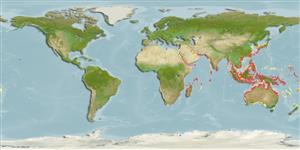sub class Elasmobranchii (ฉลามและกระเบน) (sharks and rays) >
Myliobatiformes (Stingrays) >
Rhinopteridae (Cownose rays)
Etymology: Rhinoptera: Greek, rhinos = nose + Greek,pteron = fin, wing (Ref. 45335).
More on authors: Müller & Henle.
Environment: milieu / climate zone / depth range / distribution range
นิเวศวิทยา
เกี่ยวกับทะเล,น้ำเค็ม; กร่อย เกี่ยวกับหินโสโครก. Tropical; 30°N - 15°S, 55°E - 135°E (Ref. 114953)
Indo-West Pacific: Oman to the Philippines; north to Ryukyu Is.; south to eastern Indonesia.
ขนาด / น้ำหนัก / Age
Maturity: Lm ? range ? - ? cm
Max length : 165 cm WD เพศผู้/กระเทย; (Ref. 114953); น้ำหนักสูงสุดที่มีการรายงาน: 4.5 kg (Ref. 3965)
Double-lobed snout and indented forehead; jaws usually with 7 rows of plate-like teeth; no caudal fin (Ref. 5578). Brown above, white below (Ref. 5578).
Found in bays, estuaries, and near coral reefs (Ref. 12951), over sand and mud bottoms (Ref. 9710). Usually solitary or in small aggregations (Ref. 114953). However, large schools with up to 500 individuals have been reported (Ref. 12951). Feeds on clams, oysters and crustaceans (Ref. 12951). Lives to over 2 years in captivity (Ref. 12951). Ovoviviparous (Ref. 50449). Edible (Ref. 30573). Caught mainly by gill net fisheries (Ref. 114953), occasionally by bottom trawl, demersal inshore gillnet and tangle net fisheries. Utilized for its meat (Ref. 58048).
Life cycle and mating behavior
วัยเจริญพันธุ์ | การสืบพันธุ์ | การวางไข่ | เซลสืบพันธ์ของเพศเมีย(ไข่) | ความดกของไข่ | ตัวอ่อน
Males court by nipping the female's dorsum. Mating pair orient in a venter to venter position, and the male inserts one or both claspers. The pair usually rests on the substrate, with the female on top of the male. Mating lasts about 30 seconds (Ref. 12951) to 1 minute (Ref. 49562). Exhibit ovoviparity (aplacental viviparity), with embryos feeding initially on yolk, then receiving additional nourishment from the mother by indirect absorption of uterine fluid enriched with mucus, fat or protein through specialised structures (Ref. 50449). Size at birth ~60 cm WD. One large pregnant female (~130 cm WD) contained a single late-term embryo 61 cm WD (Ref.58048).
Last, P.R., W.T. White, M.R. de Carvalho, B. Séret, M.F.W. Stehmann and G.J.P. Naylor, 2016. Rays of the world. CSIRO Publishing, Comstock Publishing Associates. i-ix + 1-790. (Ref. 114953)
IUCN Red List Status (Ref. 130435)
Human uses
การประมง: การค้า; การตกปลาเป็นกีฬา: ใช่
ข้อมูลเพิ่มเติม
ชื่อสามัญชื่อพ้องกลไกการเผาผลาญพลังงานผู้ล่าการศึกษาเกี่ยวกับผลกระทบของสารประกอบทางเคมีที่เป็นอันตรายต่อสิ่งมีชีวิต ประชากร และสิ่งแวดล้อมการสืบพันธุ์วัยเจริญพันธุ์การวางไข่การรวมกลุ่มวางไข่ความดกของไข่เซลสืบพันธ์ของเพศเมีย(ไข่)Egg development
อ้างอิงการเพาะเลี้ยงสัตว์น้ำประวัติการเพาะเลี้ยงสัตว์น้ำสายพันธุ์พันธุศาสตร์ElectrophoresesอัตราพันธุกรรมโรคการแปรรูปNutrientsMass conversion
เครื่องมือ
Special reports
Download XML
แหล่งที่มาจากอินเตอร์เน็ต
Estimates based on models
Preferred temperature (Ref.
123201): 24.2 - 29.2, mean 28.4 °C (based on 3123 cells).
Phylogenetic diversity index (Ref.
82804): PD
50 = 0.5039 [Uniqueness, from 0.5 = low to 2.0 = high].
Bayesian length-weight: a=0.01122 (0.00647 - 0.01946), b=2.94 (2.78 - 3.10), in cm total length, based on LWR estimates for this species & (Sub)family-body (Ref.
93245).
ระดับชั้นอาหาร (Ref.
69278): 3.5 ±0.24 se; based on food items.
ความสามารถในการกลับคืนสู่ปกติ (Ref.
120179): ต่ำมาก, เวลาต่ำสุดที่จะทำให้ประชากรเพิ่มขึ้นเป็น 2 เท่าใช้เวลามากกว่า 14 ปี (Fec=1-2).
Fishing Vulnerability (Ref.
59153): Very high vulnerability (85 of 100).
Nutrients (Ref.
124155): Calcium = 5.55 [0.68, 83.89] mg/100g; Iron = 0.366 [0.030, 4.005] mg/100g; Protein = 20.9 [15.6, 26.2] %; Omega3 = 0.0676 [, ] g/100g; Selenium = 30.8 [5.7, 156.0] μg/100g; VitaminA = 18.7 [1.7, 205.1] μg/100g; Zinc = 0.824 [0.056, 9.302] mg/100g (wet weight);
